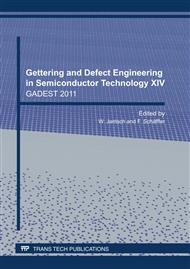p.192
p.201
p.205
p.211
p.217
p.221
p.226
p.233
p.243
Formation of Voids in SiO2/Si Substrate by Zn Implantation and Thermal Annealing
Abstract:
There are investigated the structural properties of 64Zn+ ion-beam induced nano-size voids in as implanted and subsequent furnace annealing SiOSuperscript text2/Si(100) substrates. Then 64Zn+ ions with energy of E=100keV were implanted into SiO2 layer to a fluence of D=2×1014cm-2. After this furnace thermal annealing at temperature 400°C during 1h in neutral (nitrogen) atmosthere was made. It is revealed, that in as-implanted sample the surface is non-uniform and there is some structurization of a SiO2 layer. In this state, metal Zn NPs an order of ten nm in diameter are formed in the depth region around the projected range. There is thus a net flux of Zn out of the nanoparticles (NPs) into an oxide layer closer to the surface. As Zn has a big diffusion constant and a high vaper pressure there are occured out-diffusion of Zn from a SiO2 surface layer. The volume occupied by the Zn NPs becomes a void. It results to formation of cavities, which combining among themselves, form voids.
Info:
Periodical:
Pages:
217-220
Citation:
Online since:
August 2011
Keywords:
Price:
Сopyright:
© 2011 Trans Tech Publications Ltd. All Rights Reserved
Share:
Citation:


